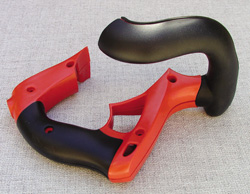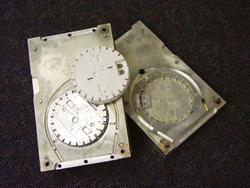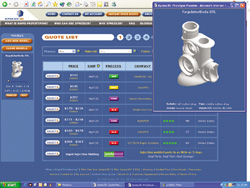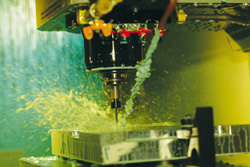Hitting Their Stride It’s Just the Beginning
Service bureaus are no longer an emerging phenomenon, and there's still a lot of room to grow.
Latest News
August 1, 2004
By Glen Hartwig
Tenns are a gangly bunch, with lots of expectations, moving in all sorts of directions at once, and harboring questions about where to go from here. Service bureaus offer that same impression. Opinions are all over the lot on everything from fundamental assumptions about the health of the business to what the short- and medium-term futures look like.
The Real ThingOne of the first things to notice about the service bureau universe is that a lot of activity nowadays seems to focus on custom or short-run production. Brad Cleveland, president of Protomold Co. of Maple Plain, Minnesota, sets the perspective for his company. “We are a rapid injection molding company,” he says. “Our business focus is on low volumes of injection-molded parts. We are typically used after rapid prototyping by design engineers who are developing new products, have already checked form and fit using RP, and need to get some real physical plastic parts to verify functionality.”
Cleveland explains his niche: “We have a way of making the tools very, very quickly and turning around parts in five days as opposed to five weeks. So we fit nicely in between rapid prototyping and conventional injection molding.”
Cleveland says that people seem to be getting the message that service bureaus provide real value. According to him, “Our business is growing very fast—each year we are twice the size we were the year before.” As to the reasons behind Protomold’s progress and rapid growth, Cleveland points out some simple reasons: “It’s because we’re fast, we’re inexpensive, and we make real parts.”
While new technologies are helping service bureaus gain greater acceptance in some areas, there are other technologies—with great potential—still hoping to find their way. Hytec, Inc. of Los Almos, New Mexico, is one example. Hytec uses CAT scanning to create high-precision 3D images.
According to Naomi Engleman, the company’s director of operations, “What we’re in is the upstream scanning that creates the digital data for the downstream rapid prototyping and manufacturing.” Take, for example, orthodontics, Engleman says, “What we do is the scanning of dental impressions and send the digital data that we create from our scan to the manufacturer, who imports that into their software, which then goes directly into the rapid prototyping and manufacturing of their braces.”
Using Protomold’s rapid injection molding process, Trapeze skipped rapid prototyping and, using its CAD design, went directly to functional testing and production ramp-up of its Mobility Point housing. The Trapeze Networks Mobility Point is a system device that augments secure mobility and provides WLAN connectivity for users. |
While the scanning process can create images of high definition and complexity, it might still be a little too hip for the room. “Our type of scanning was originally developed for three dimensional scanning so you can see inside the part,” says Engleman. With today’s technologies, though, she notes that “you can’t build a part that has interior components through rapid prototyping yet. So, really, most of the people who use rapid prototyping can get away with laser scanning, which is much more affordable than ours.
Engleman predicts “it will change over time. Prices will go down and more people will want to do a purely digital process, but right now ]our customers] are still just a very few leaders in the field.”
Molding and Casting Overseas?While some areas of service work may be a bit ahead of the curve, other areas are well entrenched and moving ahead on a more classic business development schedule. According to Steve Stewart, president of Protogenic, Inc. of Westminster, Colorado, the most exciting aspect of the field these days is new materials. “Another very interesting thing that we’re considering is the SLS market, i.e., sintering,” he says. “We’ve been investigating the claims that people can directly manufacture products ]using the SLS process] instead of just prototyping. In other words, for someone who just needs 100 parts a year in an ABS-type material, it may well suit them to just make those 100 parts using an SLS-type process instead of trying to make a mold and casting them. It could wind up being significantly cheaper and perhaps even have better properties.”
But Stewart worries about the future. “My biggest problem with the world in general is how all the manufacturers in the United States are fleeing to China,” he says. “For a while we were confident that at least the designs were going to stay here. Then, several months ago we got e-mails from companies in China doing solid model CAD design for $10 per hour. What we thought was not going to affect us too badly turns out to be something that I’m fairly concerned about.”
Interesting TwistStill, not all of the issues about going offshore relate to how little overseas workers get paid. Rick Chin, president of Xpress 3D, Inc. of Shrewsbury, Massachusetts, actually sees the current discussion over outsourcing as potentially favoring U.S. rapid prototyping in general and service bureaus in particular.
“We have customers now who are doing rapid casting,” he says. “They’re using a rapid prototype in an investment casting foundry and the really lovely thing about this is that they’re able to get true castings of their design in about three to four weeks. They wouldn’t have seen a first article casting from overseas for as much as four to five months. Most of the designs come through very clean, but there was one where there was some leaking in a particular part. They had plenty of time to go back ]to the service bureau] and refine the design and go through another iteration of these rapid castings, avoiding what could have been a four- to eight-month delay.”
There are other trends that Chin sees as providing a benefit in the days to come: “One of the biggest things that’s going to affect rapid prototyping in general is how the hardware vendors are lowering the prices on their machines. On the surface, service bureaus might get nervous about that trend, thinking that now people are going to order their own equipment,” he says. “Long term, that may be the case. But the adoption rate for these machines is so slow, relative to the overall amount of rapid prototyping that’s going on, that the fact that the hardware vendors are lowering their prices is a good thing for the service industry. Now they’re helping to bring rapid prototyping to the forefront.”
In spite of a certain amount of angst, the teen years are still a time of boundless potential and enthusiasm for the future. There’s something fundamentally reassuring about that. The whole profile of the service bureau industry is one where people think fast and are light on their feet. Today’s environment is one in which this technology seems to be thriving.
Glenn Hartwig is a technical writer who lives in southwestern New Hampshire. You can send him your feedback about this article through e-mail c/o Desktop Engineering Feedback.
HYTEC, Inc.
505-661-3000
website
Protogenic, Inc.
303-252-0212
website
Protomold
763-479-3680
website
Xpress3D, Inc.
800-315-0432
website
Subscribe to our FREE magazine, FREE email newsletters or both!
Latest News
About the Author
DE’s editors contribute news and new product announcements to Digital Engineering.
Press releases may be sent to them via [email protected].










